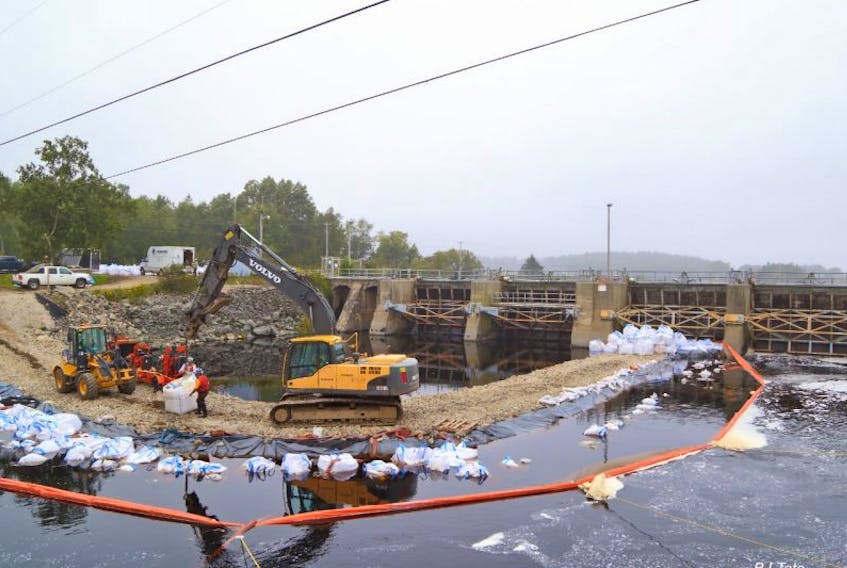Construction on the Tusket Main Dam Refurbishment Project began this summer. The riverbed work will cease for six months in order for the gaspereau fishing season to occur. Starting June 1, 2018, contractors will continue building for another six months.
The new dam structure will be built in front of the existing one, with no change in Lake Vaughan water elevations during or after the project, says NS Power.
David Rodenhiser, senior manager of communications & public affairs for Nova Scotia Power, says right now the team is awaiting environmental approval to be able to pour concrete underwater, related to pumping out the area between the dam and the cofferdam, which is used to isolate an area of the riverbed for construction activities.
“Once complete, the area between the cofferdam and the main dam will be pumped out using portable diesel water pumps to achieve a dry area for construction,” he said.
A floating silt boom outside the cofferdam captures any silt that may have been contained within the rock and keeps it from flowing downstream.
Work is expected to continue on land until the end of December to replace the Hurlburt Falls Bridge (the bridge parallel to the dam.) The time frame is subject to change, based on the delivery dates for the pre-fabricated steel bridge. Once the delivery date has been confirmed, ova Scotia Power will work to ensure that Lake Vaughan Road is not closed for any longer than necessary.
The bridge will go in new at its present location and the alignment will stay the same. A pre-fabricated bridge could be used first as a temporary structure and then as a permanent replacement structure. During the process there could be a week without any bridge access.
In other progress to date, Nova Scotia Power has selected both the general contractor (Elliot Excavators) and the gate manufacturer Mecan Hydro, and engineering for the gates is underway.
Permits from the provincial environment department and DFO have been received and a review of the capital project by the Nova Scotia Utilities and Review Board is underway.
As the Tusket hydro system is a known area of cultural significance, NS Power has been actively engaged with the Mi’kmaq.
“Through our engagement, Nova Scotia Power, Acadia First Nation and the Kwilmu'kw Maw-klusuaqn Negotiation Office established a working group early this year to have collective discussions around any issues of concern,” said Rodenhiser.
The working group meets monthly and there are weekly updates between meetings. As a result of these discussions, Acadia First Nation has a Mi’kmaq observer who is on site at Tusket for construction and archaeological work.
A new dam structure is needed to meet Canadian guidelines that were updated in 2007. Since 2008, Nova Scotia Power has been addressing dam structures throughout the province to bring them in line with the guidelines. There are 178 structures across the province, and NS Power began work with high-risk structures first.
More about the Tusket hydro system
The Tusket hydro system has a generation capacity of 2.7 megawatts and generates approximately 12,000 megawatt-hours per year. This represents approximately 1.1 per cent of the total annual hydroelectricity generated in Nova Scotia. While the generation amount is comparatively small on a province-wide basis, Tusket is an important part of the renewable strategy and is a significant generation source for Yarmouth County.
The total renewable generation in Yarmouth County – Tusket hydro, and wind turbines at Pubnico Point, Little River, Wellington, Black Pond, Brenton and Wedgeport – produces enough electricity to power about 12,000 homes. Tusket has been generating electricity since 1929, and decommissioning the site would cost more than reinvesting in the hydro system so that it can continue providing clean energy for future generations.









